Dams are incredible feats of human engineering and natural wonders, and the Usoi dam in Tajikistan is no exception. Located in the Central Asian nation of Tajikistan, the Usoi Dam is a feat of natural engineering. The dam’s story reminds us of nature’s astonishing power.
At a whopping 1,860 feet (567 meters) tall, the Usoi Dam is by far the tallest in the world—more than two and a half times as high as the better-known Hoover Dam. The Hoover Dam is located on the Colorado River on the border of Nevada and Arizona and stands at 726 feet (221 meters) tall.
Let’s take a closer look at the Usoi Dam, its engineering, and some of its impressive features.
The Tallest Dam In The World: The Usoi Dam
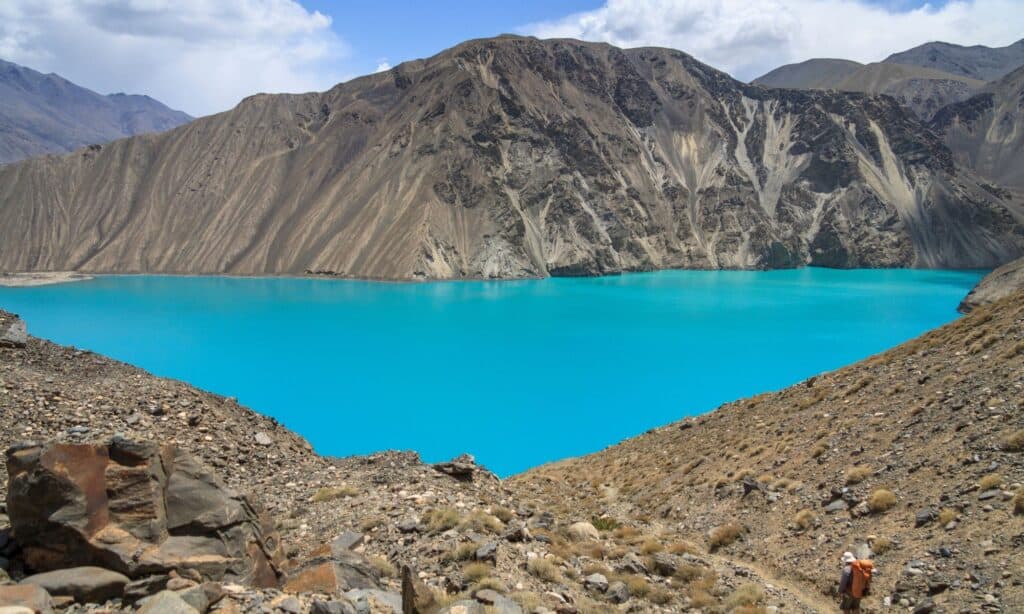
The rockfill and landslide-created Usoi dam is located on the Murghab River in Tajikistan.
©Nodir Tursunzade/Shutterstock.com
The Usoi Dam is an incredible structure, standing 2.5 times taller than Hoover Dam! It is a rockfill and landslide-created dam located on the Murghab River in Tajikistan. The Usoi Dam stands an impressive 1,860 feet (567 meters) tall and 4,490 feet (1,370 meters) long.
It has a volumetric capacity of 0.48 cubic miles or 2 cubic kilometers, creating Sarez Lake with an area of 19,700 acres (7,970 hectares). The maximum water depth is 505 meters (1,657 ft).
A natural dam is a landslide or avalanche formed from seismic activity. The Usoi Dam was created due to an earthquake-induced rock slide that completely blocked the Bartang River in Tajikistan’s Pamir Mountains on February 18, 1911.
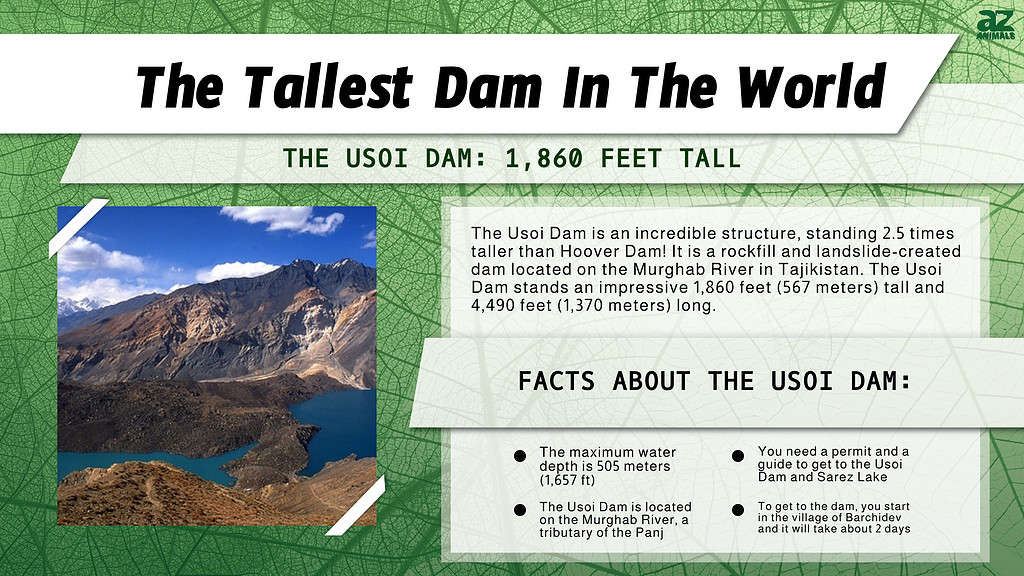
The Tallest Dam In The World Compared With The Hoover Dam
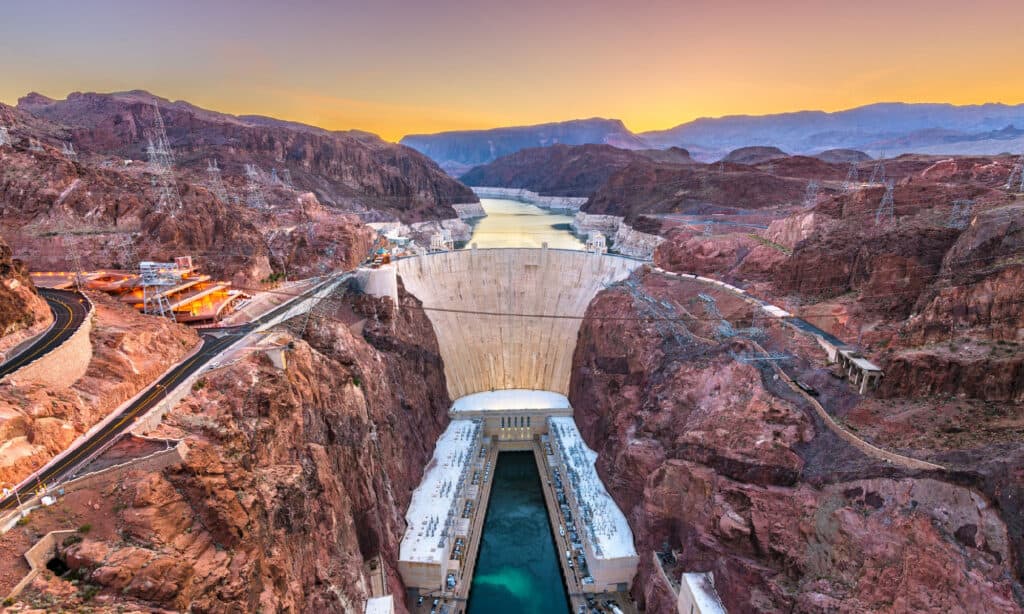
The Hoover Dam is the second-largest dam in the U.S.
©iStock.com/Sean Pavone
Compared to the better-known Hoover Dam in Nevada, USA, the Usoi Dam is far taller. The Hoover Dam stands 726 feet tall and has a maximum water depth of 459 feet. It is also much smaller than the Usoi Dam, with a volumetric capacity of 0.02 cubic miles, compared to the Usoi Dam’s 0.48.
The Hoover Dam is an impressive structure in its own right and has significantly impacted the region. It provides irrigation to California’s Imperial Valley and hydroelectric power to Arizona and Nevada. Millions of people visit the Hoover Dam each year. When the dam was completed in 1935, it was the tallest man-made dam ever built, making this an iconic feat in the history of mankind. Despite the Hoover Dam’s impressive size, it still pales compared to the Usoi Dam.
The Tallest Dam In The World: Where Is The Usoi Dam Located On A Map?
Tajikistan is a stunning country in Central Asia’s heart, bordered by Uzbekistan, Afghanistan, Kyrgyzstan, and China. It is a sparsely populated country with around 10 million people, but its diverse natural landscapes, towering mountains, and deserts leave visitors to this small nation in awe. In fact, 93% of the country is covered in mountainous terrain.
The Usoi Dam is located on the Murghab River, a tributary of the Panj and, therefore, to the Amu Darya. This breathtaking natural wonder is located in Tajikistan’s Pamir Mountains, which lie in the highlands of Tajikistan and extend into Afghanistan, China, and Kyrgyzstan.
How To Get There
You must trek to the Usoi Dam by starting in the village of Barchidev. The total trek there and back will take around 2 days, and you will need to walk about 18.5 miles or 30 kilometers, give or take a few. During this trek, you will climb to the top of the Usoi Dam to see the views of Lake Sarez and Shadau Lake. Then, you’ll climb to the edge of Lake Sarez, where you will spend the night near the Sarez Lake Risk Monitoring Station. Finally, the next morning you begin the trek back to Barchidev.
While the trek will take around 2 days, you must also account for the transport to and from Khorog, the region’s capital, which will take another few days. So, if you plan to visit the Usoi Dam and Sarez Lake, account for 4 days of travel at the very least!
Since you need a permit and a guide to get to the Usoi Dam and Sarez Lake, this trek can be expensive. But the Usoi Dam is worth the journey and provides visitors with stunning views of the surrounding landscape. It is spectacular during the summer when the lush green valleys are a sight to behold.
The Tallest Dam In The World: The Future Of The Usoi Dam
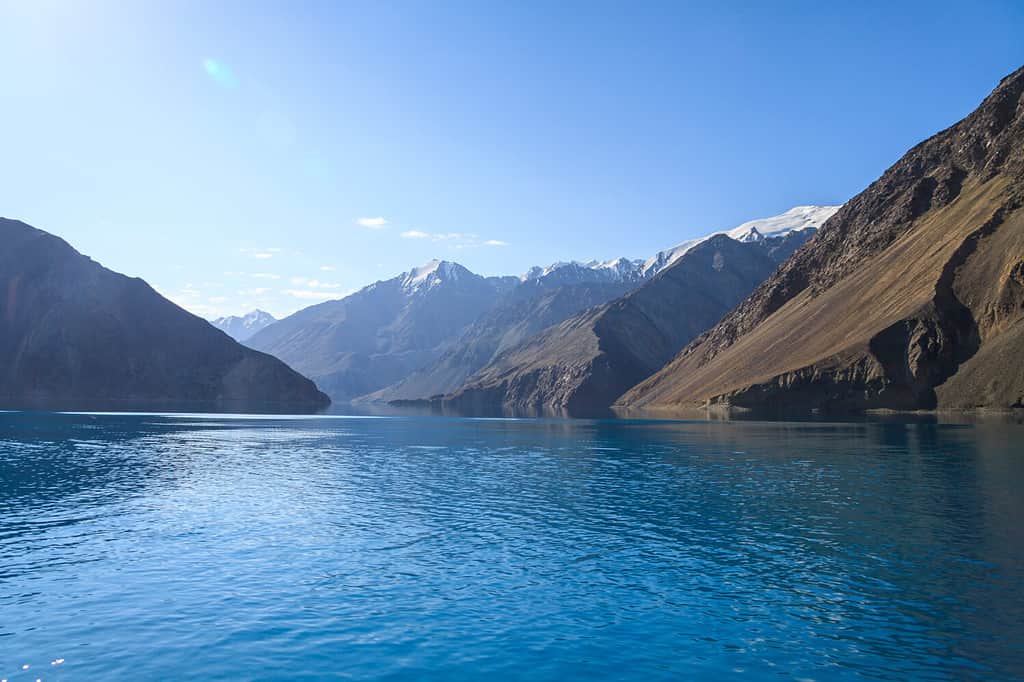
Usoi Dam resulted from a massive
earthquake
that occurred in 1911, and its future is uncertain.
©Nodir Tursunzade/Shutterstock.com
Natural dams are susceptible to erosion and collapse as they are exposed to the elements. The Usoi Dam is no exception, and its future has been a significant concern for locals and authorities alike.
Usoi Dam resulted from a massive earthquake that occurred in 1911, and its future is uncertain. Experts inspect the dam every five years, but it is difficult to predict when an earthquake or another catastrophic event may occur, and the dam could be at risk of collapse.
In 2015 the dam survived a 7.2 magnitude earthquake, and many experts warn that another such event could cause the dam to be destroyed.
Experts are also concerned about climate change and the potential for increased sedimentation, which can devastate the dam. The Usoi Dam is an area of great seismic activity. It is vital to ensure that it is inspected regularly and maintained to continue to provide the region with its benefits.
What Will Happen If The Usoi Dam Falls?
In the 1911 earthquake, the whole village of Usoi was destroyed. If the dam collapses, it could cause a devastating flood, damaging farmland and villages downstream. The large quantities of water would flood towns and cities, causing much destruction.
The Tallest Dam In The World: Wildlife Near The Usoi Dam
Dams are incredible structures that can transform entire landscapes, and the Usoi Dam is no exception. The area around the dam has a rich biodiversity, with hundreds of species of animals living in its vicinity.
The Usoi Dam is home to a wide range of fauna, including various birds and mammals.
Birds
The Usoi Dam is an essential stopover for migratory birds, making it a great spot to observe them during migration. Species such as the black stork, white-tailed eagle, and red-footed falcon may be seen in the area. In addition to observing these birds, birdwatchers can see species like brown-headed gulls, oriental turtledoves, and blue rock thrushes.
Mammals
The area surrounding the Usoi Dam (and around Lake Sarez and in the Pamirs) is home to a great many mammals, Pamir ibexes, Marco Polo Sheep, and even rare snow leopards.
Pamir Ibexes

Pamir ibexes have a thick, shaggy coat that ranges in color from light brown to grayish-brown, which helps provide insulation against the cold mountain climate.
©akimov konstantin/Shutterstock.com
The rugged landscape surrounding the Usoi Dam is home to various unique wildlife, including the Pamir ibex. These wild goats are found in the mountainous regions of the Pamir mountains, where the Usoi Dam is located, and their distinctive features make them easy to spot in the rocky terrain.
Pamir ibexes have a thick, shaggy coat that ranges in color from light brown to grayish-brown, which helps provide insulation against the cold mountain climate. Both males and females have large, curved horns. Their horns can grow up to 4 to 5 feet long, which is almost as long as the average 10-year-old child! The horns are used for defense against predators and during mating rituals. The males can weigh up to 300 pounds.
These wild goats are herbivores and primarily feed on grasses, herbs, and shrubs. In the summer months, they can also consume lichens and mosses. Their diet varies depending on the availability of food in their habitat.
Pamir ibexes are well-adapted to living in rocky, mountainous terrain and are often found in steep, rugged areas above the tree line. They can easily climb steep cliffs and rocky outcroppings, using their strong legs and hooves for balance.
Due to their remote habitat and elusive nature, Pamir ibexes are challenging to study and monitor. However, the region’s conservation efforts have helped protect this species from overhunting and habitat loss. The Usoi Dam area is an essential habitat for the Pamir ibex and is an excellent location for wildlife enthusiasts to spot these impressive creatures in their natural habitat.
Marco Polo Sheep
Another large mammal you may come across in the Usoi Dam area is the Marco Polo sheep. This sheep is a subspecies of argali sheep found in the high mountains of Central Asia. These large sheep can weigh up to 300 pounds and have impressive spiraled horns that can grow up to 4 to 5 feet in length. The Marco Polo Sheep have a distinctive white coat with a brownish-gray saddle patch on their backs, and their underbellies are usually lighter in color.
Marco Polo sheep are herbivores and primarily feed on grasses, herbs, and other vegetation found in the mountainous terrain. They have adapted to live in high-altitude regions where food sources can be scarce, and they can go without water for up to several days.
These sheep typically inhabit steep and rocky terrain at elevations of 12,000 to 17,000 feet. They prefer to live in areas with good visibility and are known for their impressive jumping abilities, which they use to move around mountainous terrain.
Unfortunately, habitat loss and hunting threaten the Marco Polo sheep population, as their meat and horns are highly valued. Conservation efforts have been implemented to protect the species, including establishing protected areas and restricting hunting.
Snow Leopards
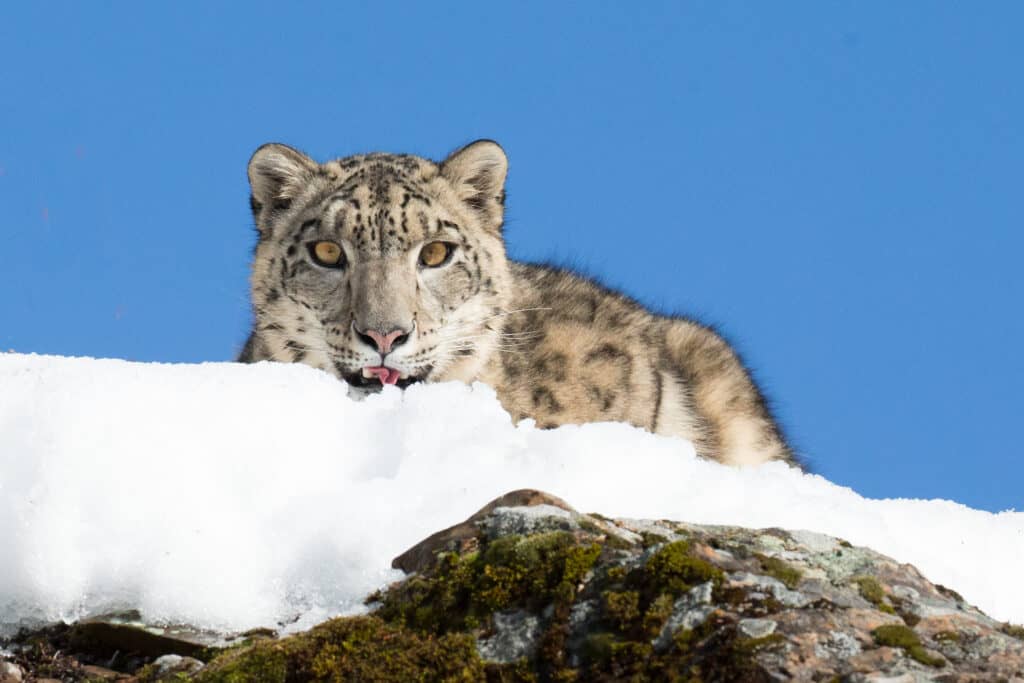
Snow leopards are adapted for life in cold habitats.
©Warren Metcalf/Shutterstock.com
The Usoi Dam area is home to the internationally protected snow leopard. This region is one of the few places in the world where this rare species can be seen. They are usually found in the high mountain ranges around the dam.
Snow leopards are one of the world’s most endangered big cat species. Their population is facing an alarming decline due to poaching and habitat loss. Only an estimated 4,000-6,000 snow leopards are left in their natural habitat.
These big cats are around 40 to 50 inches long, with males slightly larger than females. Snow leopards are about 24 inches tall. Male snow leopards generally weigh between 100 to 120 pounds, with females weighing less at around 77 to 88 pounds.
Snow Leopard Facts
The snow leopard has a thick and silky fur coat that helps it to blend in with its mountainous surroundings. In addition, the underside of the snow leopard is paler than the top, allowing it to blend in even better. Its fur also has a reflective quality that helps it absorb heat. It also helps to keep it warm in the cold temperatures of its habitat. The snow leopard’s coat also helps it to survive by providing camouflage from predators like wolves and other big cats.
The snow leopard is a solitary animal, preferring to roam alone in its territory. It is a skilled hunter and uses ambush tactics to catch its prey. When it does catch its prey, it will often drag it up.
Snow leopards can be seen in the wild in their habitat as early as February and late April. Though it is not common to encounter one, you might see a snow leopard as you trek through the wild.
The photo featured at the top of this post is ©
Thank you for reading! Have some feedback for us? Contact the AZ Animals editorial team.







